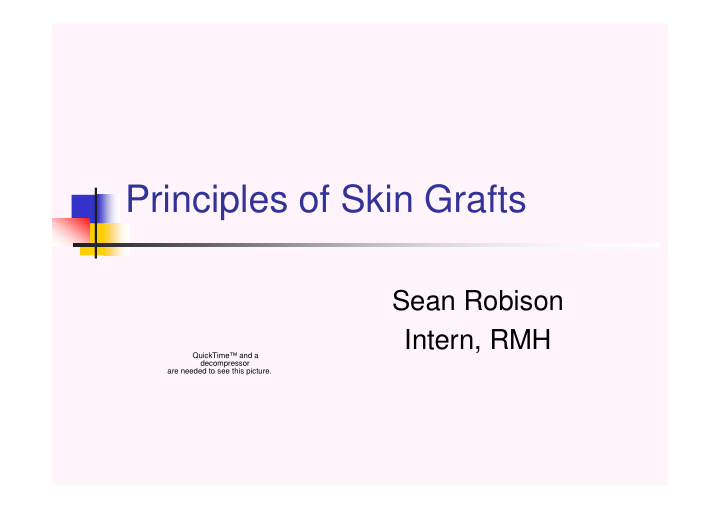



Principles of Skin Grafts Sean Robison Intern, RMH QuickTime™ and a decompressor are needed to see this picture.
Anatomy Epidermis � Stratified squamous epithelium/ keratinocytes � Melanocytes and Langerhan’s cells QuickTime™ and a decompressor are needed to see this picture.
Dermis � Papillary dermis � Thinner � Loose connective tissue QuickTime™ and a � Elastic fibers decompressor are needed to see this picture. � Reticular fibers � Some collagen
� Reticular dermis � Thicker � Dense connective tissue � Larger blood vessels � Closely interlaced elastic fibers � Coarse, branching collagen fibers arranged in layers parallel to the surface � Fibroblasts � Mast cells � Nerve endings/sebaceous glands/hair follicles � Lymphatics � Some epidermal appendages
Functions of Skin � Protective barrier � Trauma � Radiation � Infection � Thermoregulation � Vasoconstriction/constriction � Insensible fluid loss control
History of Skin Grafts � Full thickness grafts first successfully QuickTime™ and a decompressor are needed to see this picture. transplanted in sheep by Baronio of Milan in 1804, � Humans by Buenger QuickTime™ and a decompressor of Germany in 1823 are needed to see this picture.
When and why QuickTime™ and a decompressor are needed to see this picture. � Trauma � Burns � Skin lesion � Defect � Wound healing QuickTime™ and a � Cosmetic decompressor are needed to see this picture.
Phases of graft take � Phase One (0-48 hours) � Plasmatic Imbibition - diffusion of nutrition from recipient bed � Phase Two (2-3 days) � Inosculation - vessels in graft connect with those in recipient bed � Phase Three (3-5 days) � Neovascular Ingrowth - graft revascularised by ingrowth of new vessels into bed
Types of grafts � Partial thickness (split skin graft thin/thick) � 100% epidermis and part of dermis � Full thickness QuickTime™ and a decompressor QuickTime™ and a are needed to see this picture. decompressor are needed to see this picture.
Split skin grafts � Indications QuickTime™ and a decompressor are needed to see this picture. � No primary closure � Large wounds 5-6cm � Advantages � Surface coverage � Drainage � Disadvantages � Cosmetic QuickTime™ and a decompressor are needed to see this picture. � Limitations
Full thickness QuickTime™ and a decompressor are needed to see this picture. � Indications � Small wound - facial/hand � Advantages � Colour match � Cosmetic QuickTime™ and a decompressor are needed to see this picture. � Less contraction � Disadvantages � Blood supply QuickTime™ and a decompressor are needed to see this picture. � Donor wound � Cant reharvest
Donor site QuickTime™ and a QuickTime™ and a decompressor are needed to see this picture. decompressor are needed to see this picture.
QuickTime™ and a decompressor are needed to see this picture. QuickTime™ and a decompressor are needed to see this picture. QuickTime™ and a decompressor are needed to see this picture.
Post graft care � Pressure � Dressings � Infection � Contracture
Complications QuickTime™ and a decompressor � Infection are needed to see this picture. � Haematoma/Seroma � Traction � Contraction � Rejection � systemic factors QuickTime™ and a � unsuitable site decompressor are needed to see this picture.
Biological agents � Cell cultures � Spray-on skin
Case Study QuickTime™ and a decompressor are needed to see this picture.
QuickTime™ and a decompressor are needed to see this picture.
QuickTime™ and a decompressor are needed to see this picture.
QuickTime™ and a decompressor are needed to see this picture.
QuickTime™ and a decompressor are needed to see this picture.
QuickTime™ and a decompressor are needed to see this picture.
QuickTime™ and a decompressor are needed to see this picture.
QuickTime™ and a decompressor are needed to see this picture.
QuickTime™ and a decompressor are needed to see this picture.
QuickTime™ and a decompressor are needed to see this picture.
QuickTime™ and a decompressor are needed to see this picture.
QuickTime™ and a decompressor are needed to see this picture.
QuickTime™ and a decompressor are needed to see this picture.
QuickTime™ and a decompressor are needed to see this picture.
Recommend
More recommend